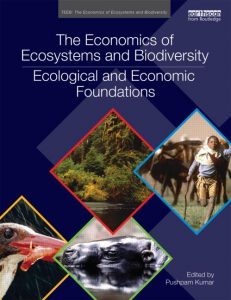- TEEB
- TEEBAgriFood
- Natural Capital Accounting
- TEEB Country Studies
- TEEB Water & Wetlands
- Other publications
- TEEB Case Studies (2009-2013)
- TEEB: Challenges and Responses (2014)
- Natural Capital Accounting and Water Quality: Commitments, Benefits, Needs and Progress – A Briefing Note (2013)
- TEEB Valuation Database Manual (2013)
- Nature and its Role in the Transition to a Green Economy (2012)
- Implementation Guide for Aichi Target 2: A TEEB Perspective (2012)
- Implementation Guide for Aichi Target 3: A TEEB Perspective (2012)
- Implementation Guide for Aichi Target 11: A TEEB Perspective (2012)
- Why Value the Oceans? A Discussion Paper (2012)
- TEEB Manual for Cities: Ecosystem Services in Urban Management (2011)
- TEEB Climate Issues Update (2009)
- TEEB Interim Report (2008)
TEEB: Ecological and Economic Foundations
 This report brings together decades of research in science and economics to provide the most comprehensive and up-to-date overview of the economics of ecosystems and biodiversity.
This report brings together decades of research in science and economics to provide the most comprehensive and up-to-date overview of the economics of ecosystems and biodiversity.
A team of international experts presents the theory, approaches and challenges in valuing nature in an effort to improve understanding of the economics costs of biodiversity loss and ecosystem degradation.
The book can be purchased from Routledge here. A full draft version is available for free download.
Download full draft report
Suggested citation: TEEB (2010), The Economics of Ecosystems and Biodiversity Ecological and Economic Foundations. Edited by Pushpam Kumar. Earthscan: London and Washington.
You may also be interested in TEEB: Challenges and Responses
